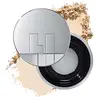Morphe Bake And Set Setting Powder Versus Haus Labs By Lady Gaga Bio-Blurring Talc-Free Loose Setting Powder
What's inside
What's inside
 Key Ingredients
Key Ingredients

 Benefits
Benefits

 Concerns
Concerns

 Ingredients Side-by-side
Ingredients Side-by-side

Mica
Cosmetic ColorantAluminum Starch Octenylsuccinate
AbsorbentSilica
AbrasiveLauroyl Lysine
Skin ConditioningBoron Nitride
AbsorbentDimethicone/Vinyl Dimethicone Crosspolymer
Skin ConditioningTocopheryl Acetate
AntioxidantIsoceteth-10
EmulsifyingCaprylyl Glycol
EmollientEthylhexylglycerin
Skin ConditioningPhenoxyethanol
PreservativeCI 77891
Cosmetic ColorantCI 77491
Cosmetic ColorantCI 77492
Cosmetic ColorantCI 77499
Cosmetic ColorantCI 16035
Cosmetic ColorantCI 19140
Cosmetic ColorantMica
Cosmetic ColorantSqualane
EmollientDiphenyl Dimethicone/Vinyl Diphenyl Dimethicone/Silsesquioxane Crosspolymer
Methyl Methacrylate Crosspolymer
Synthetic Fluorphlogopite
Arnica Montana Flower Extract
MaskingPseudozyma Epicola/Sunflower Seed Oil Ferment Extract Filtrate
Emulsion StabilisingTourmaline
Tocopherol
AntioxidantPentaerythrityl Tetra-Di-T-Butyl Hydroxyhydrocinnamate
AntioxidantCaprylyl Glycol
EmollientEthylhexylglycerin
Skin ConditioningTocopheryl Acetate
AntioxidantGlycerin
HumectantTriethoxycaprylylsilane
C20-24 Olefin
Skin ConditioningAlumina
AbrasiveIron Oxides
CI 77891
Cosmetic ColorantCI 19140
Cosmetic ColorantMica, Squalane, Diphenyl Dimethicone/Vinyl Diphenyl Dimethicone/Silsesquioxane Crosspolymer, Methyl Methacrylate Crosspolymer, Synthetic Fluorphlogopite, Arnica Montana Flower Extract, Pseudozyma Epicola/Sunflower Seed Oil Ferment Extract Filtrate, Tourmaline, Tocopherol, Pentaerythrityl Tetra-Di-T-Butyl Hydroxyhydrocinnamate, Caprylyl Glycol, Ethylhexylglycerin, Tocopheryl Acetate, Glycerin, Triethoxycaprylylsilane, C20-24 Olefin, Alumina, Iron Oxides, CI 77891, CI 19140
 Reviews
Reviews

Ingredients Explained
These ingredients are found in both products.
Ingredients higher up in an ingredient list are typically present in a larger amount.
Caprylyl Glycol is a humectant and emollient, meaning it attracts and preserves moisture.
It is a common ingredient in many products, especially those designed to hydrate skin. The primary benefits are retaining moisture, skin softening, and promoting a healthy skin barrier.
Though Caprylyl Glycol is an alcohol derived from fatty acids, it is not the kind that can dry out skin.
This ingredient is also used as a preservative to extend the life of products. It has slight antimicrobial properties.
Learn more about Caprylyl GlycolCI 19140 is also known as Tartrazine. Tartrazine is a synthetic dye used in cosmetics, foods, and medicine to add a yellow color.
Tartrazine is created from petroleum and is water-soluble.
Some people may experience allergies from this dye, especially asthmatics and those with an aspirin intolerance.
Learn more about CI 19140Ci 77891 is a white pigment from Titanium dioxide. It is naturally found in minerals such as rutile and ilmenite.
It's main function is to add a white color to cosmetics. It can also be mixed with other colors to create different shades.
Ci 77891 is commonly found in sunscreens due to its ability to block UV rays.
Learn more about CI 77891Ethylhexylglycerin (we can't pronounce this either) is commonly used as a preservative and skin softener. It is derived from glyceryl.
You might see Ethylhexylglycerin often paired with other preservatives such as phenoxyethanol. Ethylhexylglycerin has been found to increase the effectiveness of these other preservatives.
Mica is a naturally occurring mineral used to add shimmer and color in cosmetics. It can also help improve the texture of a product or give it an opaque, white/silver color.
Serecite is the name for very fine but ragged grains of mica.
This ingredient is often coated with metal oxides like titanium dioxide. Trace amounts of heavy metals may be found in mica, but these metals are not harmful in our personal products.
Mica has been used since prehistoric times throughout the world. Ancient Egyptian, Indian, Greek, Roman, Aztec, and Chinese civilizations have used mica.
Learn more about MicaTocopheryl Acetate is AKA Vitamin E. It is an antioxidant and protects your skin from free radicals. Free radicals damage the skin by breaking down collagen.
One study found using Tocopheryl Acetate with Vitamin C decreased the number of sunburned cells.
Tocopheryl Acetate is commonly found in both skincare and dietary supplements.
Learn more about Tocopheryl Acetate